Green papaya salad or som tum is world famous for a reason. It's an explosion of flavour and texture. For Thai people, som tum occupies a place in our hearts and on our palates that no other dish can replace. In this post I'll guide you through the making of the most popular kind of Thai papaya salad, which is the classic Thai-style or som tum thai. It is easy, but there are many important things to know!

First, what exactly is som tum?
Som tum ส้มตำ is not a single dish, but a whole category of salads which originated from the Northeast of Thailand and Laos. What defines a som tum is 2 things: first, the spicy and sour dressing that is unique to these salads, and second, it must be made in a mortar and pestle (though there are ways around it which we will discuss). The clue is also in the name; som means sour, and tum means to pound in a mortar and pestle.
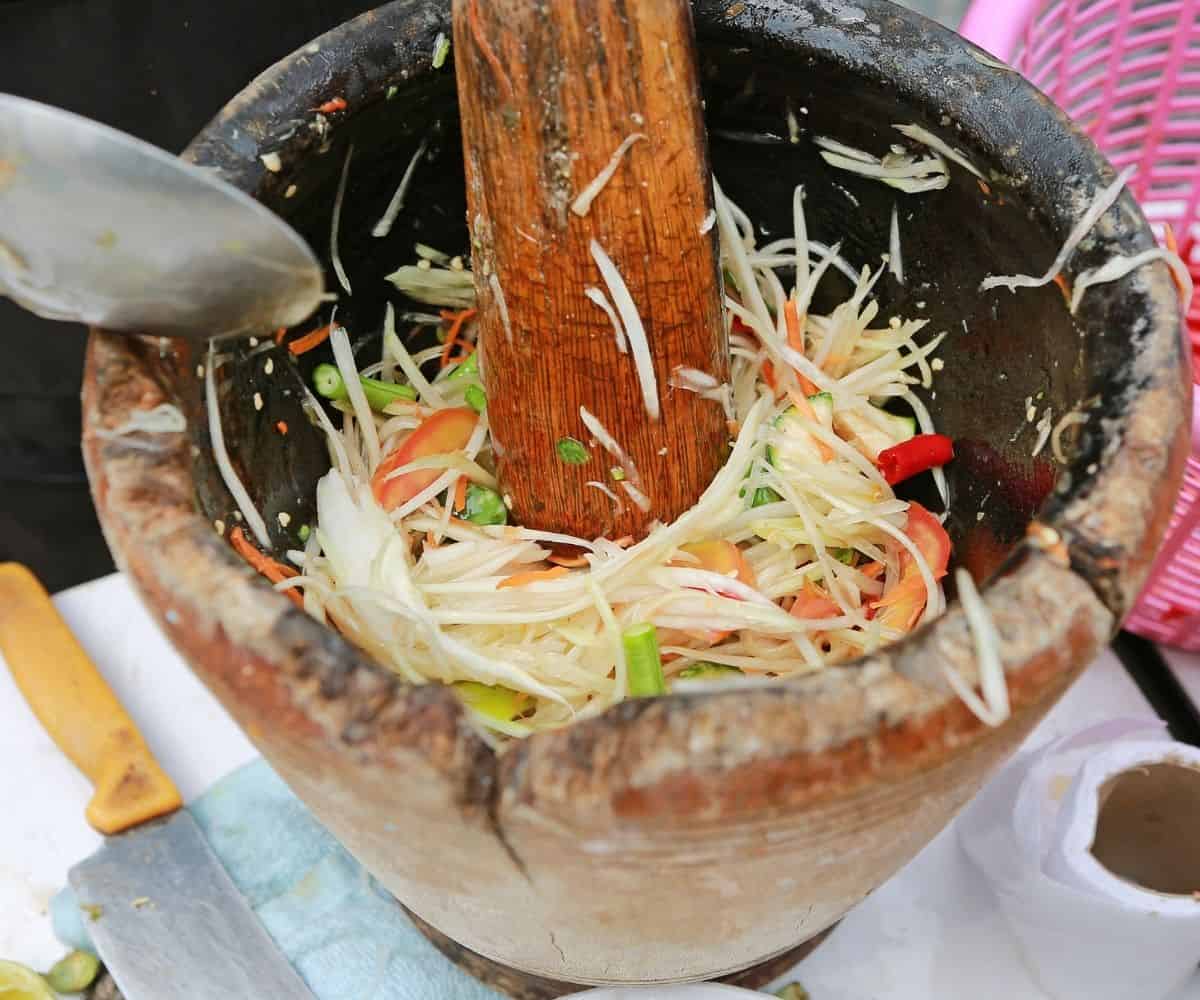
Fun Fact: In the Northeast of Thailand, this dish is referred to as tum som instead of som tum!
Though it is called a green papaya salad in English, and indeed most som tum involves green papaya, som tum doesn't actually require any papaya at all. You can make som tum with any kind of vegetables, fruits, or even meats. Try this apple and chayote salad or corn and cucumber salad for example!
Som tum is widely available in Thailand both as street food and in sit-down restaurants. People also commonly make it at home. And though it originated from the Northeast, and indeed that is where it is most frequently consumed, it is a dish that has spread throughout the country.
Types of Som Tum
This recipe is for som tum thai or Thai-style papaya salad, but there are hundreds of kinds of som tum. Today, more than ever, people are becoming increasingly creative with ingredients they use.
Here are some common types of som tum that are worth knowing about:
- Som tum thai - Thai style papaya salad (this recipe). This is the type most commonly offered in Thai restaurants overseas, and it is one of the most popular type in Thailand as well. It uses roasted peanuts, dried shrimp, tends to be a little sweet, and does not use pla ra, a type of fermented fish sauce.
- Som tum lao/som tum pla ra - Lao style papaya salad. This is another very popular one that is a favorite of those who love funkiness and a lot of umami. In addition to regular fish sauce, it uses pla ra, a fermented fish sauce made from freshwater fish, which is thicker and more pungent than regular fish sauce. It does not use any peanuts or dried shrimp. See my recipe for som tum pla ra here.
- Tum Sua - Lao style papaya salad with rice noodles. The noodles we add are specifically kanom jeen, which are round rice noodles that are often referred to as "rice vermicelli" in Vietnamese restaurants.
- Tum Tang - Cucumber salad. Uses cucumber instead of papaya, the dressing can be Thai style or Lao style.
Don't let the above common types limit your imagination. We also add salted duck eggs, corn, raw Thai eggplant, pickled crab, Vietnamese ham, fruits, and all kinds of things. Think of som tum like a salad bar, the options are endless!
Ingredients for Thai Style Papaya Salad
Now let's get to making som tum! Here are all the ingredients you'll need for Thai style papaya salad, and important notes about them. For amounts, see the full recipe card below.
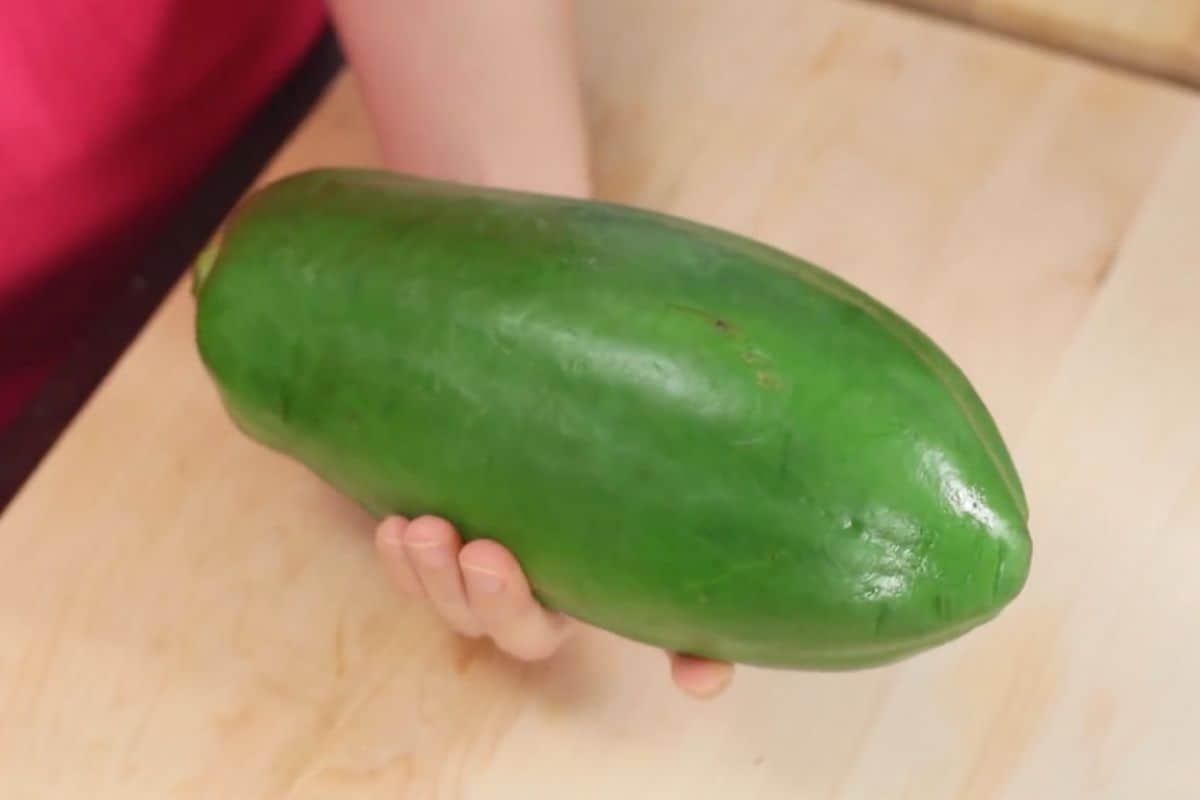
- Green papaya, julienned. Green papaya is an underripe papaya, but you want to use the large ones (about 10-12 inches long) common in Southeast Asia, not the small Hawaiian ones. You can find green papaya at Asian stores that carry Vietnamese/Thai/Lao products. More on HOW to julienne green papaya and what to use instead below.
- Long beans. If you don't have long beans you can substitute green beans. The long beans we add are eaten raw. If you want to use green beans, I find they taste a bit better if you blanch them in boiling water for 15 seconds - apparently some people also have a hard time digesting raw green beans.
- Roasted peanuts. I prefer buying raw peanuts and roasting my own as they taste much better than pre-roasted ones. And if you're at an Asian grocery store, red skin-on peanuts are also tastier! Simply roast them in a 350°F oven for 15-20 minutes, depending on the size.
- Dried shrimp, chopped if large, think of them as shrimp jerky. They're chewy, umami, salty bits that will add flavour and texture to the salad. If possible get medium size ones so they're meatier, and not the papery thin ones as those will not add any texture and tend to just disappear into the salad.
- Tomatoes. Any kind of tomatoes will work for this, though in Thailand the tomatoes we use are closer to a large grape tomato. Tomato juices will add lots of great flavour to the dressing
- Serving suggestion: sticky rice and BBQ chicken are classic pairings with papaya salad!
Papaya Salad Dressing Ingredients
As I mentioned, the dressing is one thing that defines a som tum, and the art of som tum dressing lies in the delicate balance of sweet, salty, sour and spicy. While there are variations to the dressing, the ingredients below are common to most som tum, so you can think of these as the "basic" som tum dressing ingredients that you can build upon.
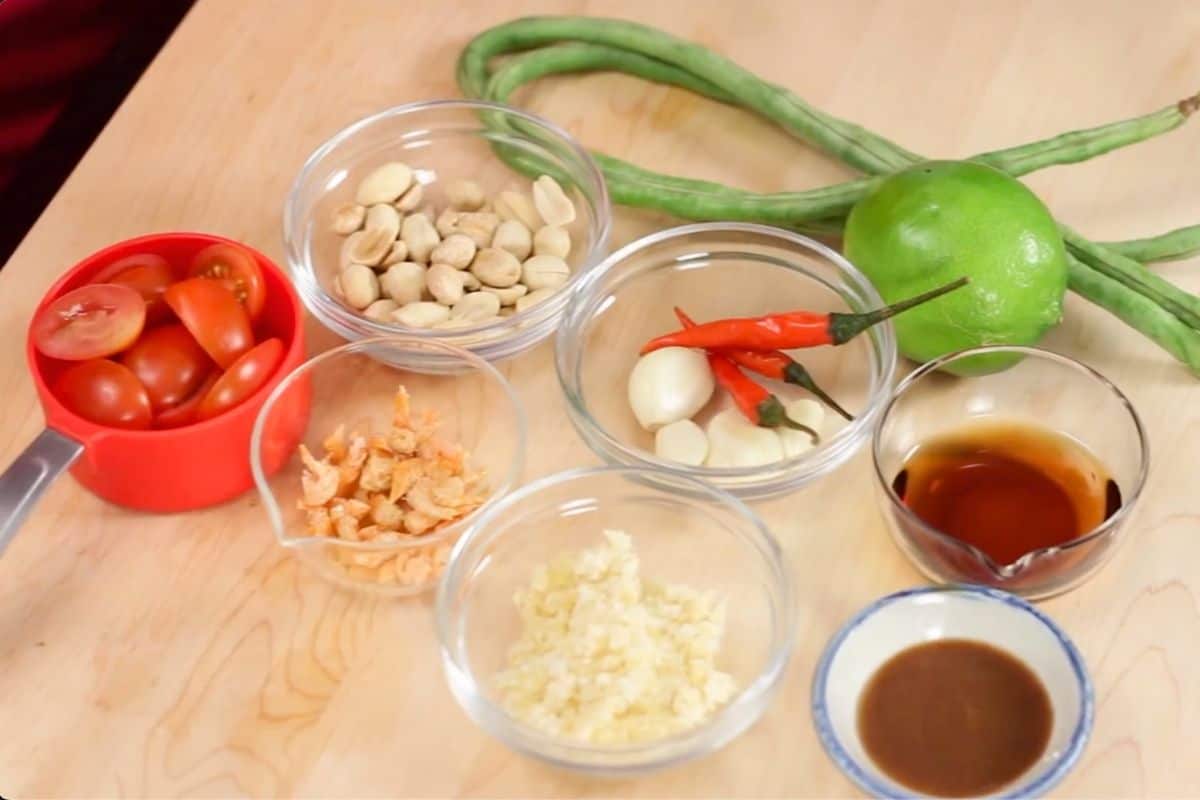
- Garlic.
- Thai chilies, to taste. Som tum is supposed to be spicy, but feel free to make it as spicy as you can tolerate. Starting with 1 Thai chili is fine, and if you're so inclined, adding 10-15 chilies isn't uncommon in Thailand! However, if you like it very mild, I recommend not omitting the chilies, but rather removing the seeds and pith from 1 Thai chili. This is because the flavour of chilies is important to the dressing, and if you omit them altogether you will be missing this flavour note.
- Palm sugar. It's important to use palm sugar as it provides a caramelly flavour in addition to sweetness. If not available, you can substitute light brown sugar or even maple syrup. Read more about palm sugar here.
- Fish sauce. This is what will add saltiness and umami to our dressing. Learn more about how to choose good quality fish sauce here.
- Fresh lime juice. We have sweet, salty, and now the most important flavour of som tum, the sour! Lime juice is a critical ingredient in all types of som tum. Always squeeze it fresh from a lime for best flavour, do not use bottled lime juice for this!
- Tamarind paste. Tamarind paste is a sour liquid made from combining tamarind pulp with water. Though it is not strictly necessary since we are already adding lime juice, I find the acidity to be more well rounded when we combine tamarind and lime together. You can buy tamarind paste already made in a tub (often called tamarind concentrate) or make it easily from tamarind pulp using my DIY tamarind recipe here. (Do not buy tamarind concentrate from India as it is very different)
3 Ways to Julienne Papaya
Julienning the papaya is perhaps the hardest part of the recipe (and it isn't that hard) but the shape of the papaya DOES affect how it tastes, so it's important to at least get the size close to how it should be. Here are 3 methods you can use:
If you want to see a demo of the 3 ways to julienne papaya, watch this YouTube video tutorial from my Lao style papaya salad video.
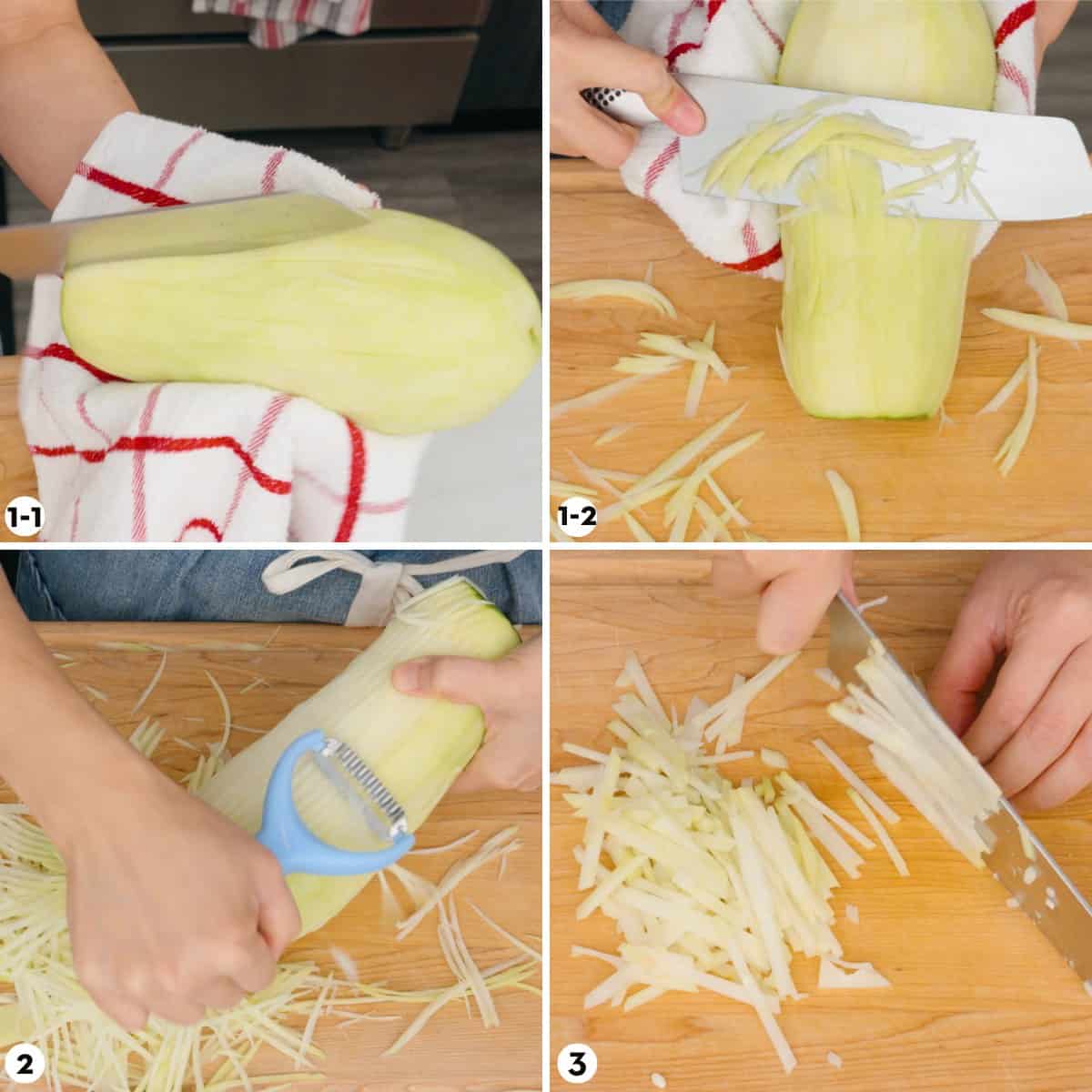
Method 1 - Traditional method: (1-1)use a chef's knife and chop-chop-chop to make many incisions on the papaya, then (1-2) use the knife to shave off a layer and you should get beautiful uneven sticks.
Method 2 - Julienne peeler. You can buy a Thai julienne peeler at many Asian stores and online (Kiwi brand). This is what I do at home as it's convenient and fast. Note that the first layer you peel off will be stuck together into a sheet, which you simply have to hand-chop into sticks.
Method 3 - Hand chop. If method 1 is too scary, and you don't have a peeler, you can also just hand chop it! It's slow but it will work. Halve the peeled papaya, scrape off the seeds, and thinly slice into sheets, then chop the sheets into sticks.
Tools: The Mortar and Pestle
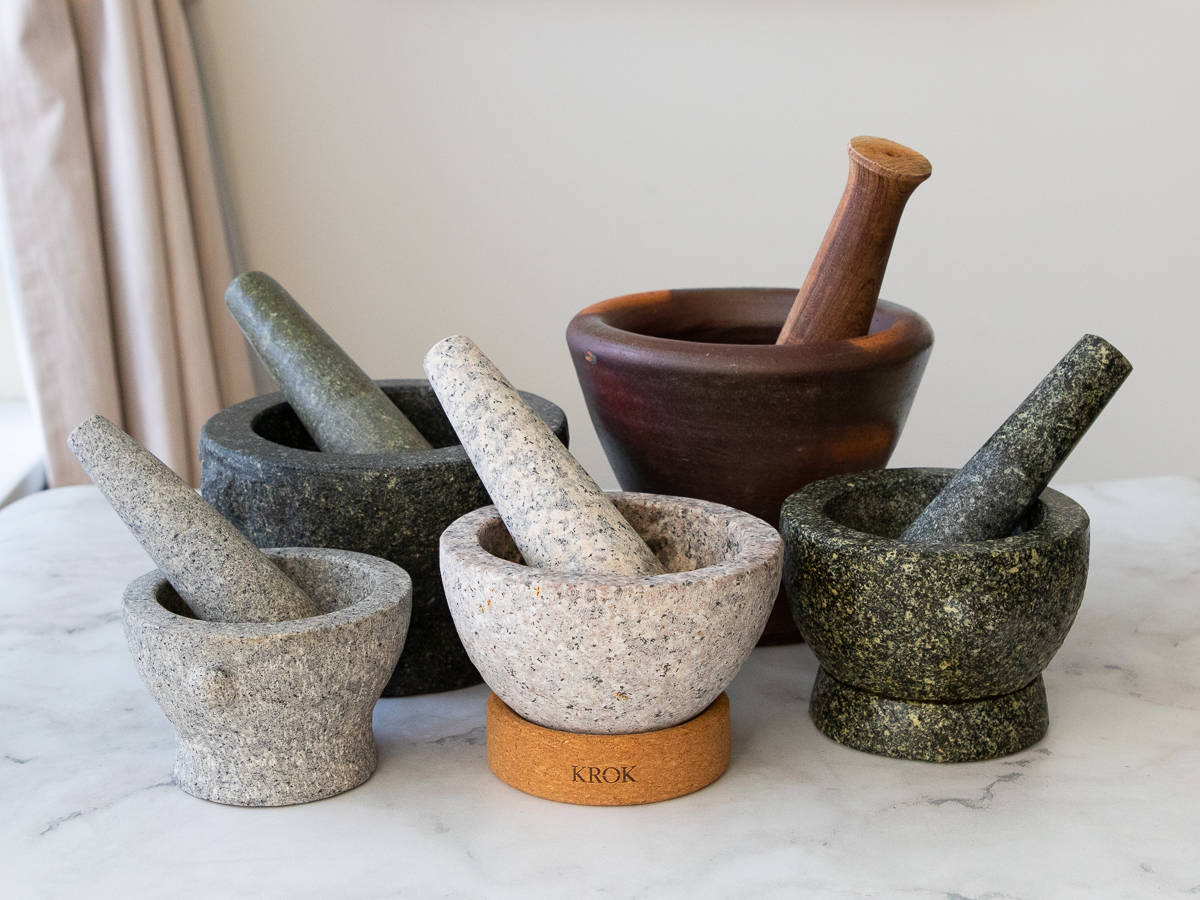
Before we get to making it, we have to talk about the mortar and pestle since it is the first requirement of a som tum. And indeed "tum" means to pound in a mortar and pestle! Though there are ways to do it without one (more on this below), if you are going to make papaya salad with some regularity, it is worth investing in a set.
Thai people use a large set of mortar and pestle designed specifically for making papaya salads, but if you already own a smaller "all-purpose" set, you can probably still use it for part of the process, as I'll discuss in the methods.
Mortar and pestles made for papaya salad are larger than most granite ones, because it needs to be large enough to hold the whole salad in it. In the picture above, the tallest, brown set in the back is what we use specifically for som tum. The mortar is made of clay or wood, and the pestle is always made from wood because we do not want to pound the salad too heavily.
How to Make Som Tum
Here's a bird's eye view of the process, for the full recipe and ingredient amounts, see the recipe card below!

- Peel and julienne the papaya into short sticks using one of the methods above.
- Optional: For extra crunchy papaya, soak it in ice water while you prep other ingredients, 15-20 minutes will do, but longer is fine.
- Drain the papaya very well, and then place in on a towel to absorb excess water. If making a lot, spread the papaya out on a towel-lined baking sheet, then put another towel on top and rub it to remove as much water as possible. This is very important as you do not want excess water to dilute the dressing.
- In a mortar and pestle, pound the garlic and chilies until there are no more big chunks.

- Add chopped palm sugar and pound until it's dissolved into a paste.
- Add the long beans and pound lightly just until the beans are broken.
- Add the peanuts and dried shrimp and pound a few times to break up the peanuts.
- Add all the liquid seasoning: tamarind, fish sauce, and lime juice, and throw in the juiced lime skin into the mortar as well; the oil in the skin will add flavour to the dressing. (Don't eat the skin, obviously!) Use a large spoon to stir to mix.

- Add the drained papaya and the tomatoes. If your mortar is too small to hold the papaya and tomatoes, transfer to a mixing bowl and use the "hand massage" method shown in the section below.
- Pound using the pound-and-flip method: First, pound the papaya a few times, then use a large spoon to flip the bottom up to the top so the dressing comes up to the top.
- Pound a few more times, then flip it from the bottom up again. Do 4-5 rounds of the pound-and-flip until the salad looks well mixed and the papaya looks a little wilted.
- Plate and top with more peanuts if you like, enjoy!
How to Make Papaya Salad WITHOUT a Mortar and Pestle
No mortar? No problem! We can mimic the pounding action in other ways.
If you want to see a demo of how to make papaya salad without a mortar and pestle, watch my youtube video demo here.
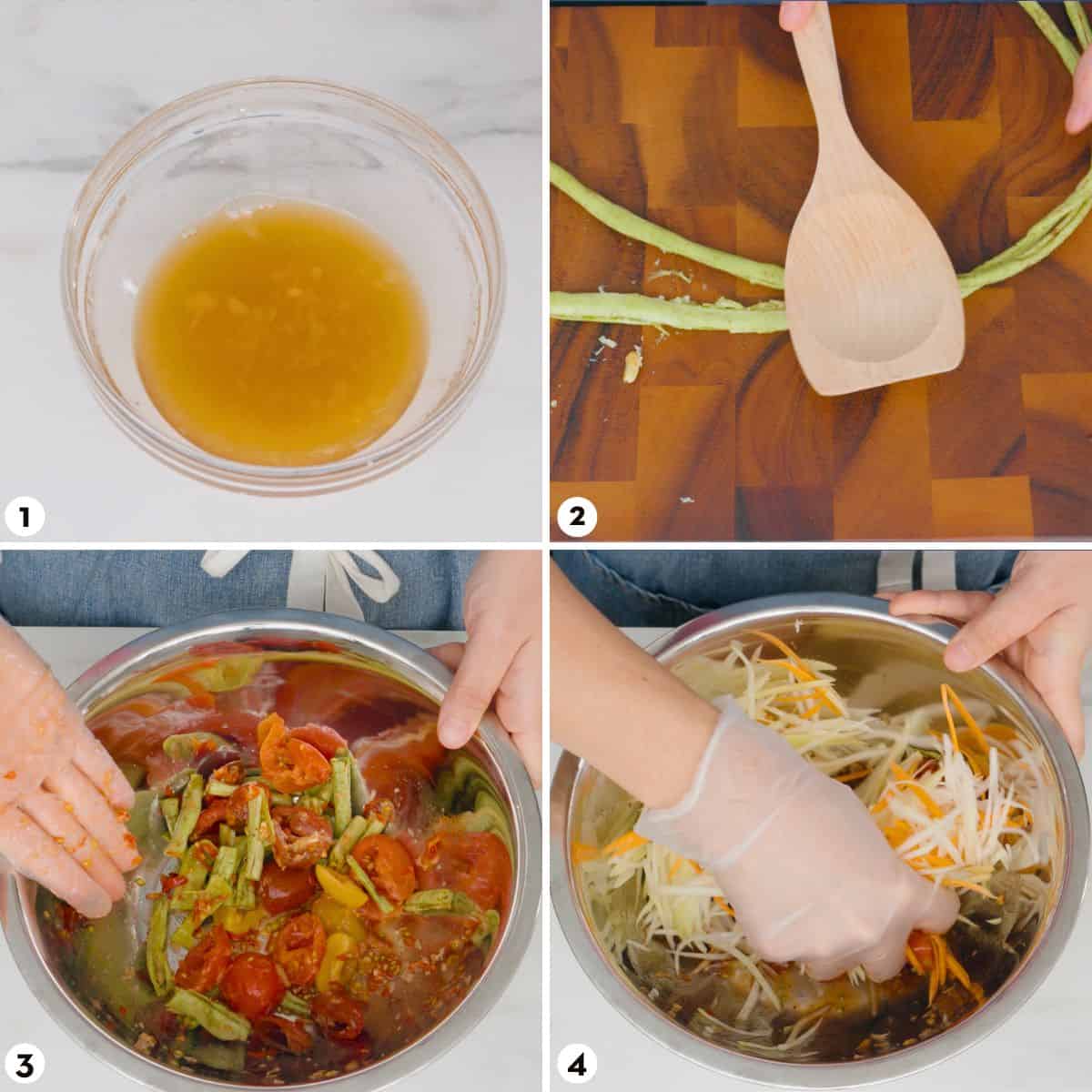
- Chop the palm sugar finely and combine it with the fish sauce and lime juice. Stir to dissolve most of the sugar, and let it sit while you prep other things. Once ready to use, the lumps of sugar should be easily smashed with the back of a spoon. Add the tamarind to the dressing once the sugar has dissolved.
- Smash the long beans until broken with anything that'll do the job, and chop the peanuts.
- Finely mince the garlic and chilies, then add to a mixing bowl along with the long beans, tomatoes, peanuts and dried shrimp. Use a gloved hand to massage everything and release the tomato juices into the dressing.
- Add the papaya and massage everything together with your hand.
Watch The Full Video Tutorial!
All my recipes come with step-by-step video tutorials with extra tips not mentioned in the blog post, so make sure you watch the video below to ensure success! And if you enjoy the show, please consider subscribing to my YouTube channel. Thank you!
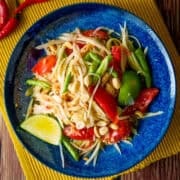
Thai Green Papaya Salad ส้มตำไทย (som tum)
- Prep Time: 25 mins
- Cook Time: 5 mins
- Total Time: 30 minutes
- Yield: 2 servings
- Cuisine: Thai
Description
Authentic recipe for Thai green papaya salad (som tum). This version is the Thai style or "som tum thai" that is most commonly offered in Thai restaurants overseas.
Ingredients
Save this recipe!
- 1 ½ cups julienned green papaya (see blog post above for how to julienne papaya)
- 2 cloves garlic
- Thai chilies, to taste
- 1 ½ Tbsp (18 g) palm sugar, finely chopped, packed
- 3 long beans, cut into 2-inch pieces
- 3 Tbsp (45 ml) roasted peanuts (see note 1)
- 1 heaping tablespoon dried shrimp, roughly chop if you have large ones
- 2 Tbsp (30 ml) fresh lime juice (see note 2)
- 2 tsp (10 ml) tamarind paste, store bought or homemade (see note 3)
- 1 ½ Tbsp (22.5 ml) fish sauce
- ½ cup grape tomato halves or one small tomato cut into wedges
- Serving suggestion: sticky rice and BBQ chicken are classic pairings with papaya salad!
Instructions
- Optional step: Soak the papaya for about 15 minutes in ice water to help make the papaya crunchier. Drain well and place on a towel-lined plate to absorb excess water, rub the top dry with another towel; you want to have as little water on the papaya as possible so as to not dilute the dressing.
If you have a large mortar and pestle made for som tum:
- In the mortar, pound garlic and chilies into a rough paste.
- Add the palm sugar and mash with the pestle until it turns into a wet paste.
- Add the long beans and pound just until they're broken.
- Add the dried shrimp and peanuts and pound to break the peanuts up slightly so they look "roughly chopped."
- Add the fish sauce, tamarind paste, and lime juice, adding the squeezed lime skin into the mortar as well for extra lime fragrance. Stir with a large spoon to mix and dissolve the sugar.
- Add the shredded papaya and tomatoes, and mix using the pound-and-flip method as shown in the video @8:40. Once everything looks well mixed and the tomatoes are just slightly crushed, it's done!
- Plate and sprinkle with extra peanuts, if desired. For a classic Northeastern Thai meal, serve with sticky rice and the ultimate BBQ chicken
If you have a small mortar and pestle:
- Follow the instructions above in your small mortar up until you've added the fish sauce, lime juice and tamarind paste.
- Transfer the contents of the mortar into a large mixing bowl, add the tomatoes, and then with a gloved hand, squish the tomatoes gently so the juices come out into the dressing.
- Add the papaya and then mix and massage the papaya with your hand until everything is well mixed and the papaya looks slightly wilted.
- Plate and sprinkle with extra peanuts, if desired.
If you don't have any mortar and pestle:
- Combine the fish sauce, lime juice and palm sugar in a small bowl and stir until most of the sugar is dissolved. Let it sit, and don't worry about any remaining lumps for now.
- Finely mince, press, or grate the garlic with a microplane zester; add to a mixing bowl. Finely mince the chilies and add them to the mixing bowl.
- Roughly chop the peanuts and the dried shrimp (if large) and add to the mixing bowl.
- Smash the long beans with a wooden spoon until they are broken, then cut into 2-inch pieces and add to the mixing bowl.
- Stir the dressing one more time, and if there are still any lumps of palm sugar, use a spoon to press on them and they should dissolve with no issues. Once everything is completely dissolved, add the tamarind paste and stir to mix. Pour the dressing into the mixing bowl.
- Add the tomatoes to the mixing bowl and, using a gloved hand, squish the tomatoes gently so the juices come out into the dressing.
- Add the papaya and then mix and massage the papaya with your hand until everything is well mixed and the papaya looks slightly wilted.
- Plate and sprinkle with extra peanuts, if desired.
Notes
- I prefer buying raw peanuts and roasting them myself for the best flavour. Simply put them in a 350°F (175°C) oven for 15-18 minutes until they're golden, stirring them half way through for even roasting. Keep leftover roasted peanuts in the fridge or freezer to keep them fresher longer.
- If you have juicy, North American size lime, 2 tablespoon of juice is about ⅔ of the lime (so if you cut the lime the way I did in the video, you'll only need to juice piece #1 and #2).
- Tamarind paste for Thai cooking is often sold as ready-to-use liquid in tubs/jars labelled as "tamarind concentrate" or "tamarind paste." Do not use tamarind paste from India.


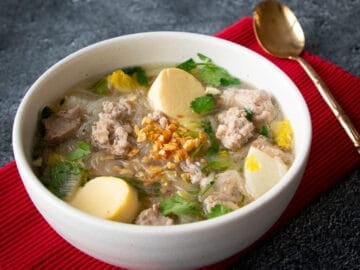
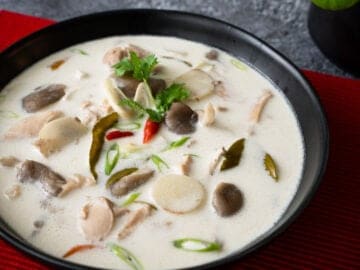
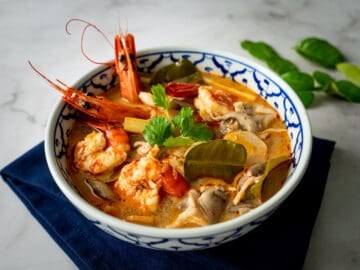
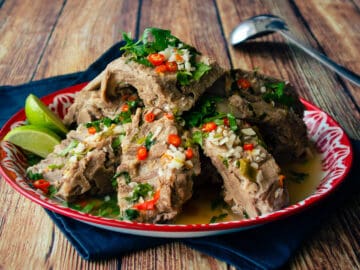
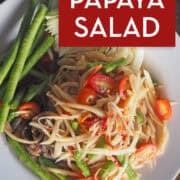
Sarah says
My family absolutely love Thai food and wanted to know if I can use regular sugar instead of palm sugar! Also do you have a recipe for udon noodles that’s made with spicy sauce made with shrimp paste?
Pailin Chongchitnant says
I would use light brown sugar instead of white sugar just so you're not eliminating flavour altogether. I don't have any udon recipes sadly 🙂
Rick says
Pailin,
Having traveled to Thailand, this is one of the dishes that I now and then crave (second to mango sticky rice!). Just made this recipe today and now I sit with a pleasant fire in my mouth so thank you very much for posting this!! I made the salad a couple of hours ago, put it in the fridge thinking that the flavors would marry a bit more, and while they have, the papaya has lost some crispness it had before placing it in the fridge. It's still quite tasty though. I might add some more of the green papaya that I didn't initially incorporate (I made a double recipe but had about 7 cups of shredded papaya) to see if that will liven the crunch and mouth feel back up.
Jessica says
I have never left a comment on a recipe, but this deserved it!! After coming back from a long holiday in Thailand I have been craving this dish daily! Even local Thai restaurants back home weren't hitting the mark! This is EXACTLY like it tasted in Thailand! I LOVED IT! Thank you so much for sharing! <3
Nyfallio says
It would be nice to know how many grams that papaya is. Are you guys really putting that stuff in cups to measure?
Peter says
This is the most authentic recipe out there. One thing I would not do again though is add the lime peel - it somehow got into the flavor of the sauce lending a somewhat bitter citrus note to the dressing. Otherwise 5 start great!
Reeta Shah says
Hi, l have to take papaya salad for pot luck dinner. How can l prepare this. I would like to keep some crunch and don’t want it to be soggy. The above recipe how many people does it serve? Thank you in advance.
Nittaya says
I’m preparing some for a potluck in the morning! If it’s the same day just make all of it at home and bring it in with an extra side of crushed peanuts. Since I’m making it tonight I’m doing everything except the tomatoes, and will pound them in before leaving the house in the am.
Adam from HTK says
Hi Reeta, Adam here and "Yield: 2 servings" (she includes servings at the top of the recipe card). Cheers!
Rajan Menghani says
I tried it it was great
Use proper serated thai papaya peeler
Alysa Nantarojanaporn says
Anytime I make a new Thai dish that's not one I make often, the first place I look for a recipe is here. My papaya salad was a hit at the company potluck.
And the tip to use a bowl of you don't have a big enough mortar was extremely helpful. I revisit this recipe all the time when I want my dish to turn out great.
Reeta Shah says
Hi Alysa,
For potluck dinner how did you take your salad. Did you mix everything before you took it or assemble on arrival. Thanks.
Sam says
Great recipe and instructions, but I cannot for the life of me find the video for this recipe on this page anywhere. You mention there's a full video tutorial, but I don't see the video anywhere on this page. Can you please help?
Pailin Chongchitnant says
It's right there on the page above the recipe, but do you have ad blockers enabled? That will block the video.
Andi Fishfingers says
We have this Thai Street Food Restaurant around the corner. When i order the papaya salad with the cancer i really don't know how to to eat it. I always crack the little crusty arms but i feel i do it wrong. How do i eat it properly?
Pailin Chongchitnant says
You mean the crab? It should be broken enough that you can suck out the sweet flesh.
Daniel says
I love the recipe! It reminds me so much of Thailand. Luckily, I am going there soon again.
For everybody who cannot get green papaya and lives in a colder country, I recently found the perfect substitute for it: turnip cabbage / kohlrabi! Trust me, it has the perfect texture and in the salad it tastes just like green papaya. I couldn't believe it before I made it myself. I am soooo happy I found this very cheap alternative to green papaya. I make som tum very often now and enjoy it with home made larb and sticky rice. Yummmmy!
Mario Raffl says
Tried it with Kohlrabi too, today. It's perfect! It's local and way cheaper than the green papaya. I also added one shredded carrot and used our local green beans (which have to be blanched).
Brad says
when I first bought the papaya it was green and the after I pealed it the inside was orange. Can I use this in som tum?
Jo says
I'm trying to increase my veg and this salad is perfect. Absolutely love it, and the pounded cabbage one in the Sabai cookbook. Thank Pailin
Yoris Wilson says
I absolutely love pawpaw salad, but have recently moved to a country where it is difficult to source pawpaw. I have been reading the comments about substituting apple,cucumber etc but was wondering if pumpkin might work
Darren Schneider says
Wow!!! Just made this for the first time , so damn easy ....always seen it made in Thailand 🇹🇭 and always thought I have to try ..... and I did. It's my go to salad to take places and share ( my mouth is on fire but loving it all the same , I doubled the sauce.) The beer is helping. My plate is now empty .
Christine Bestavros says
It's a very hot summer and I'm making Sunday dinner. I made your Ultimate BBQ chicken Gai Yang. Your instructions were awesome, even shopping was fun. I learned so much from your instructions. Paired with Green papaya salad (so yummy) and Thai rice. It was sooo delicious. I would have taken a photo but the family dug right in. Can't wait for leftovers and will definitely do again. Thank you for given my family a taste of home cooked Thai.
Tom Baker says
Great version, Pai! Because papaya is so dear here (more than steak) I like to experiment and use substitutes: thinly sliced fruit/veggies such as Granny Smith or Honeycrisp apples, cucumbers, grapes (treated like the cherry tomatoes), jicama or chayote - all work well. I also add mint or basil at times, which adds to the complexity.
I love fusion! After all, this dish is a fusion given that hot peppers did not exist in Thailand until after Columbus!
Great dish!
Jeremy says
That was my solution Tom. I don't get green Papaya in my country and whether I freeze pawpaw prior to juilienning it or throw it on top of the dish, doesn't make a difference. It's texture is always compromised. Granny smith apples are the ideal sub as they hold their own so I find them even better then papaya. Texture spot on, sour and sweet, not the other way round.
TexasGal says
What can I substitute for the shrimp and the fish sauce to make this recipe vegetarian? Thanks.
Pailin Chongchitnant says
Omit the shrimp and use soy sauce 🙂
Tim Johnson says
Hello!
How can I make this recipe vegan?
Also can I make the dressing beforehand?
We have concentrate tamarind, is that okay to use?
Joanna says
This is an absolute favorite in our home. Flawless recipe!
Alison says
Hello, is the tamarind the sweet or sour variety in this recipe? thank you
Stephen Quinn says
Thank you for your reply, I have used cucumber and ripe mango which was yummy against the spicy chillies.
Kind regards,
Stephen
Stephen Quinn says
Hi,
What alternative to green papaya or mango could be used ?
Thank you
Pailin Chongchitnant says
Any crunchy veg like cabbage, carrot,kohlrabi, or even cucumber.
Donna says
Hi, just want to check if I need to soak the dried shrimp first before adding to the salad? Also I assume they’re already cooked so no need to cook/ re-cook from the packet? Thank you!
Mario says
In most cases when using citrus it will "cook" whatever raw meats chicken, seafood, pork, beef. Not cooked in the sense of when it is cooked with heat but it does. What essentially happens when using citrus, vinegar or even wine is that the acidic values of the juices will break down the proteins. This is the reason this process is used mostly in salads. In the Latin world it is "ceviche", "hinava" in Malaysia, "kilawin" in the Philippines, "kelaguen" in Mariana Islands, "Poisson cru" in Tahiti. In Hawaii "poke" seldom is made with citrus so instead the fish is raw when consumed.
Denise says
Absolutely perfect! So fresh and it’s perfect with fish.